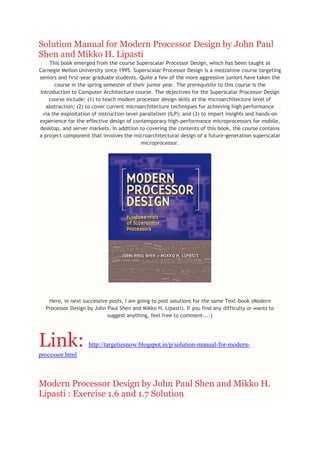
Solution manual for modern processor design by john paul shen and mikko h. lipasti
- 1. Solution Manual for Modern Processor Design by John Paul Shen and Mikko H. Lipasti This book emerged from the course Superscalar Processor Design, which has been taught at Carnegie Mellon University since 1995. Superscalar Processor Design is a mezzanine course targeting seniors and first-year graduate students. Quite a few of the more aggressive juniors have taken the course in the spring semester of their junior year. The prerequisite to this course is the Introduction to Computer Architecture course. The objectives for the Superscalar Processor Design course include: (1) to teach modem processor design skills at the microarchitecture level of abstraction; (2) to cover current microarchitecture techniques for achieving high performance via the exploitation of instruction-level parallelism (ILP); and (3) to impart insights and hands-on experience for the effective design of contemporary high-performance microprocessors for mobile, desktop, and server markets. In addition to covering the contents of this book, the course contains a project component that involves the microarchitectural design of a future-generation superscalar microprocessor. Here, in next successive posts, I am going to post solutions for the same Text-book (Modern Processor Design by John Paul Shen and Mikko H. Lipasti). If you find any difficulty or wants to suggest anything, feel free to comment...:) Link: http://targetiesnow.blogspot.in/p/solution-manual-for-modern- processor.html Modern Processor Design by John Paul Shen and Mikko H. Lipasti : Exercise 1.6 and 1.7 Solution
- 2. Q.1.6: A program's run time is determined by the product of instructions per program, cycles per instruction, and clock frequency. Assume the following instruction mix for aMlPS-like RISC instruction set: 15% stores, 25% loads, 15% branches, and 35% integer arithmetic, 5% integer shift, and 5% integer multiply. Given that load instructions require two cycles, branches require four cycles, integer ALU instructions require one cycle, and integer multiplies require ten cycles, compute the overall CPI. Q.1.7: Given the parameters of Problem 6, consider a strength-reducing optimization that converts multiplies by a compile-time constant into a sequence of shifts and adds. For this instruction mix, 50% of the multiplies can be converted to shift-add sequences with an average length of three instructions. Assuming a fixed frequency, compute the change in instructions per program, cycles per instruction, and overall program speedup. Solution:http://targetiesnow.blogspot.in/2013/11/modern-processor-design-byjohn-paul_9765.html#links